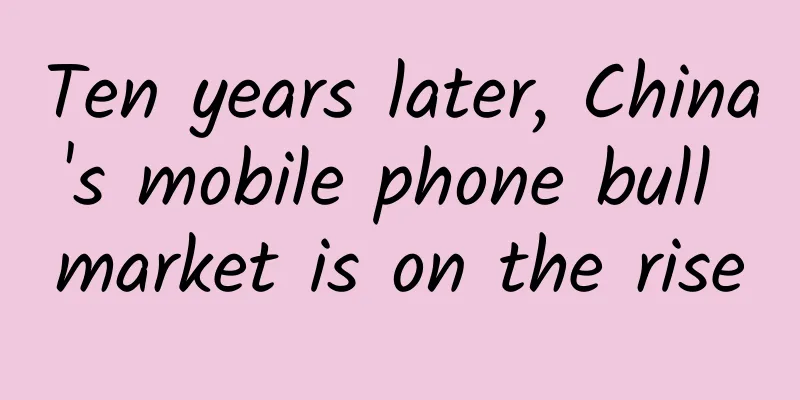Ten years later, China's mobile phone bull market is on the rise

|
When " Jack Ma " stands at the crossroads of the turbulent mobile Internet, whose mobile phones are they holding? Our lives have never been controlled by mobile phones as much as they are now. Mobile phones have evolved into a major "organ" of the body, constantly triggering new lifestyles. With this, Chinese smartphone manufacturers have also ushered in a long-awaited bull market. In 2014, despite having fierce enemies in front and pursuers behind, Chinese mobile phone makers still bravely rushed onto the world stage. The competition in 2015 is destined to be more intense. However, there are still latecomers who say "bring AK47 to the south to make mobile phones." All this is just like the poem by Dylan Thomas that is always echoing in the movie "Interstellar": Do not go gentle into that good night. Ten years later, the counterattack Chinese mobile phone manufacturers, who had previously taken advantage of the commercialization of 3G to avenge their previous failures, have finally seen a bull market after a decade: in 2014, China's 4G commercialization brought about a wave of smartphone replacement, and the wind is coming again. According to the latest data released by market research firm Gartner, among the top five smartphone manufacturers in the world in the third quarter, three were Chinese manufacturers, namely Huawei, Xiaomi and Lenovo, with a combined market share of 15.5%, a year-on-year increase of 4.1%. The top two, Apple and Samsung, had a combined market share of 37.1%, but a year-on-year decline of 7.1%. The surging shipments of Chinese smartphones are leaving international peers dumbfounded. "Where is the Mate 7? The monthly production capacity of one million units is still in short supply, and it's hard to get one." Huawei Terminal CEO Richard Yu posted a microblog late at night on December 20. In fact, the Huawei phone behind him is just a typical representative of China's smartphone shipments of over 400 million units. It took ten years for Chinese smartphones to fight back. In 2003, Chinese mobile phone brands accounted for more than 50% of the domestic market for the first time, representing the peak era of the industry. The situation reversed in 2004, when China joined the WTO for three years and technology products such as mobile phones began to be imported at zero tariffs. Foreign mobile phone giants that had been suppressed by domestic mobile phone brands made a comeback and launched low-end and mid-range mobile phones to seize the Chinese market. "A fire in the backyard." This is how TCL Chairman Li Dongsheng described the mobile phone market in 2004. In 2003, the peak era of domestic mobile phones, as the leader of domestic mobile phones, Li Dongsheng decided to acquire Alcatel's mobile phone division within three months. However, he did not expect that the sudden change in the domestic market situation in 2004 also caught him off guard. The domestic mobile phone industry hit rock bottom in 2004. The disease came like a mountain falling and went away like a thread being pulled out. What followed was a slow healing process. The most critical boost came in January 2009, when my country's 3G was officially put into commercial use. The tide of replacing feature phones with smartphones began. The three major operators began to learn from the European and American models, increased terminal subsidies, and promoted contract-customized phones on a large scale. "Thousand-yuan customized phones" became the magic weapon for operators to conquer the market, and domestic mobile phone manufacturers represented by Huawei, ZTE, Lenovo, etc. took advantage of this boost to develop rapidly. If we count from the low point of domestic mobile phones in 2004 to now, ten years have passed. Get rid of and transform Market competition is still fierce, and no one is the "Phoenix". This year, Samsung suddenly fell out of favor. After several consecutive quarters of declining performance, Samsung Electronics' net profit fell by 49% and operating profit fell by about 60% in the third quarter of 2014. Its frustration was exposed to the world. At this time, its Chinese counterparts were quietly eroding its market share. Recently, the Federation of Korean Industries (FKI) released a report showing that in the second quarter of 2014, China's global smartphone market share surpassed that of South Korea - nine Chinese mobile phone manufacturers including Huawei, Lenovo, ZTE and TCL had a total market share of about 31.3% in the world, exceeding the combined share of 30.1% of South Korea's Samsung and LG. There is no doubt that Chinese mobile phone companies will occupy more global market share in 2015. However, the reality worth pondering is that in terms of profitability, domestic brands are far behind Samsung and Apple. In October this year, the data on the operating profit margins of smartphone manufacturers released by investment bank Merrill Lynch showed that Lenovo's operating profit margin this year was only 1%. Since Huawei and ZTE did not disclose relevant data, Merrill Lynch estimated that their operating profit margins were in the high single digits. The reporter checked Coolpad Group's 2014 semi-annual report and found that the gross profit margin was 13.6% and the net profit margin after tax was about 2.8%. According to other public data, Samsung's mobile division had an operating profit margin of 18.7% in 2013, and Apple's operating profit margin in the fiscal year ending September 2013 was as high as 28.7%. On the one hand, there are impressive shipment data, but on the other hand, there are meager profit margins. Why is it so difficult for domestic mobile phones to make money? The large proportion of reliance on operator channels and price wars are to blame. With the State-owned Assets Supervision and Administration Commission requiring operators to reduce marketing expenses year by year in 2014, terminal subsidies are the first to be affected. Manufacturers who rely on operator channels are no longer having an easy time. Price wars are not a long-term solution after all, and transformation is the top priority in 2015. As a winner of Toutiao's Qingyun Plan and Baijiahao's Bai+ Plan, the 2019 Baidu Digital Author of the Year, the Baijiahao's Most Popular Author in the Technology Field, the 2019 Sogou Technology and Culture Author, and the 2021 Baijiahao Quarterly Influential Creator, he has won many awards, including the 2013 Sohu Best Industry Media Person, the 2015 China New Media Entrepreneurship Competition Beijing Third Place, the 2015 Guangmang Experience Award, the 2015 China New Media Entrepreneurship Competition Finals Third Place, and the 2018 Baidu Dynamic Annual Powerful Celebrity. |
<<: What sense of crisis should P2P online lending have?
>>: Didi Chuxing is banned: The dilemma of the government not doing social innovation
Recommend
Bandwidth configuration for renting mobile game servers?
Bandwidth configuration for renting mobile game s...
What does national coordination of pension insurance mean? When exactly will it start? Attached is the latest news!
my country has attached great importance to the n...
Fu Wei talks to Feng Ge, a cross-border e-commerce company, about how a new Amazon seller can achieve sales of $80,000 per month
Davy Zhai is a senior foreign trade person in cro...
The cost of product promotion is almost zero, how to recruit KOLs?
The promotion cost is almost zero, how to recruit...
How to increase product user growth? Share the 8-step plan!
The author uses a real case to explain how to bui...
National Healthy Lifestyle Action Day丨These 9 seemingly lazy behaviors are actually very healthy!
Today is the National Action Day for Healthy Life...
Improper makeup application may cause dry eyes! What's going on?
See this title Some girls may be surprised: I'...
ASUS Mechanical Keyboard M801 Review: A Razer Black Widow priced at 400 yuan?
As a major domestic hardware manufacturer, ASUS i...
ToB operations, 7 pitfalls to avoid
If you stand in the right place, even a pig can f...
In addition to aspartame, plants can also be "sweet"!
Excerpted from: Inside and Outside the Classroom ...
HTTPS vulnerability exposes 1,500 iOS apps to security vulnerabilities
SourceDNA, an app analytics service company, rele...
Juniper Research: Research shows that highly intelligent robots are more popular with consumers
According to data from Juniper Research, a Britis...
Is this another round of mobile phone manufacturers following suit in grabbing a spot in the VR market?
Last night, Honor released the V series' firs...
Gu Chuanling-Postpartum Nutrition Course
Gu Chuanling-Postpartum Nutrition Course Resource...









